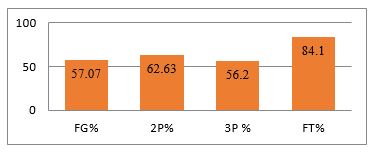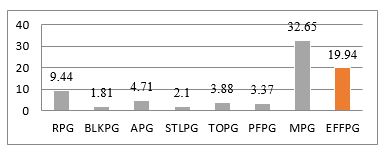Abstract
In this study, we want to perform a comparative analysis of the different positions played in basketball at the World Championship level, based on efficiency and complexity. We propose an approach from multiple points of view. In the beginning of the research, after the reviewing the documentation from the official competition site, we merged the data provided by the International Basketball Federation (FIBA) and ranked the top 10 players (regardless of the position held) out of a total of 248 subjects, according to the results obtained for the individual statistical parameters recorded in real time at the Basketball World Championship (BWC) - Spain 2014. In the second part of the research, we took in consideration the three categories of positions played: guards, forwards and centres. We then ranked the top 10 players for each category separately. In the final analysis, using the comparative method, we observed directly and interpreted the results obtained. We wanted to identify what category was the most efficient in the management of modern basketball, taking in account the parameters recorded in the game statistics. From the results achieved, we can conclude that the centres, with a value of 18.85 points for efficiency, are the category considered the most efficient in modern basketball. Following the analysis performed in this study, in current basketball, we can observe a uniformity of technical and tactical values for the player positions, through the high values noticed in the individual statistical parameters.
Keywords: Basketballanalysisgame statisticsefficiency
Introduction
Generally, coaching basketball teams to achieve performance was carried out in a complex fashion as it was based on players’ physical shape levels and anthropometric aspects (Sampaio, Drinkwater, & Leite, 2010). At the moment, specialists plan the training process and competition utilising international and national statistics analysis with the ultimate purpose of developing both their players’ and their team’s performances (Hughes & Franks, 2004; Ortega, Villarejo, & Palao, 2009; Leite, Baker, & Sampaio, 2009). National and international investigation has been described as a method of documentation, analysis and diagnostics of events that take place on the basketball court (Drust, 2010). One of the most analysed sports through notational and international analysis is basketball. Game-related statistics are very important for players, coaches and other specialists as they have been used to develop understanding of game performance in different situations (Gómez et al., 2010). The research in this field is aimed at men’s basketball teams.
In Basketball positions (2017), five player positions are mentioned in a traditional basketball team:
The point guard - is the team’s best dribbler and passer, being usually referred to as the “floor general” or “playmaker”, which indicates that this player has a key role in the team.
The shooting guard - also named the “two guard”, is usually a team’s best outside shooter. This player moves around the court trying to create some space to take a shot that is uncontested by the opposition and flanks the point guard.
In our study, both of the positions described above were integrated into a single category called “guards”, keeping the statistical model used by the FIBA.
The power forward - plays near the basket and has to move from one side of the basket to the other to get free from the opposition player that is guarding him/her or to take a good position for shooting. These players are excellent rebounders.
The small forward - is a better shooter and is smaller than a power forward.
The category “forwards” used in our study also contains the two play positions described above.
The centre - is the tallest on the basketball court and has the role to establish a position close to the basket for performing an easy jump shot. On defence, this player has the main task to block shots and make rebounds.
This is the third category herein after referred to as “centres”.
Statistical parameters of the game model that will be used in this study (a comparison between the three positions) are represented by the following: points per game – PPG; points total score – PTS; field goal percentage – FG%; two-point shooting percentage – 2P%; three-point shooting percentage – 3P%; free throw shooting percentage – FT%; rebounds per game – RPG; blocks per game – BLKPG; assists per game – APG; steals per game – STLPG; turnovers per game – TOPG; personal fouls per game – PFPG; minutes played per game – MPG; efficiency per game – EFFPG.
“This complex screen of statistics that characterises the game (14 parameters from above) has a big importance and is necessary to be taken into consideration in optimising the strategy of player training, regardless of the competition levels of the teams” (Petreanu & Petreanu, 2016, pp. 36-43).
Problem Statement
In this study, we perform a comparative analysis of the different positions played in basketball at the World Championship level, based on efficiency and complexity. We propose an approach from multiple points of view. The current methodology in basketball develops and adjusts constantly, the additions of coaches being heuristic due to the multitude of information and game situations. The data collected by recording the game statistics allow coaches to analyse them and improve the team game model, provided that they are complete and objective. Establishing the game model may change or complement the team preparation and competition model. As a result, statistical parameters of the game model and their analysis are a condition of the training and performance management of a team (Moanţă, Ghițescu, & Tudor, 2013)
Research Questions
Could the analysis of individual basketball statistics establish a hierarchy of the play positions and implicitly their efficiency?
If we know, create and analyse the ranking of parameter performances in the individual statistics during the basketball game, referring to each play position separately, then we will be able to determine which of them is more effective during a game, in terms of statistical and mathematical data. The specialists will therefore be able to develop the team tactics and play with a senior philosophy.
Purpose of the Study
The study aims to establish the level of efficiency in the game for each play position and implicitly to find out which of these play positions decisively influences athletic performance in modern basketball.
Research Methods
The study was carried out by applying some research methods in order to obtain a more accurate comparison. The research methods specific to physical education and sports, together with the statistical and mathematical methods, constituted the basis of our study. An important role was played by the documentation method and the study of available literature in the field. The large volume of information was collected from official competition websites. The subjects of our study are members of the representative teams participating in the FIBA Basketball World Cup - Spain 2014, the latest edition organised by the International Basketball Federation in a classical format. Starting with 2017, FIBA has decided to change the organization of this kind of competition. The number of analysed athletes is 248, assigned in 24 participating teams, so an average of 10.33 athletes per team, whose individual statistical data were recorded during the games. The average age of the players participating in the 2014 edition held in Spain was 27.38 years and their average height was 199.04 cm.
Findings
Figures
guards - ranked on the 1st and 3rd places;
centres - ranked on the 2nd, 6th, 7th and 8th places;
forwards - ranked on the 4th, 5th, 9th and 10th places.


From the above, we can draw a first preliminary conclusion, namely that in terms of distribution in the ranking, the category entitled “guards” holds leading positions (places 1 and 3), but with a share of representativeness diminished by 50%, as compared to the other two categories, which are represented each with 4 positions in the leaderboard. Thus, we have achieved a summarisation of the information that would lead us to another preliminary conclusion, namely that a senior/male basketball player can have as a performance but also as a preparation model the following characteristics: he/she must score more than 19 points in an actual playing time of over 30 minutes, managing percentages of over 80% on free throws, over 60% on the 2-point shots, while on the 3-point shots, he/she will need to obtain a percentage exceeding 55%.

In Figure
In Europe, the same statistical benchmark is used for analysing the players: “efficiency”. Efficiency is calculated by deriving from other statistics like points, rebounds, assists, steals, blocks, turnovers and shot attempts. Even though defence statistics like steals and blocks are counted towards “efficiency”, it is thought that an offensive-oriented player is favoured over a defensive-oriented player because it is more difficult to quantify all the defensive plays with the statistics that are used nowadays
FIBA Organiser uses an Efficiency Rating stat for basketball (Efficiency - basketball, 2017). By default, it is calculated as follows, but is customisable by League:
FIBA: (EFF) = (points + assists + blocks + steals + fouls on + rebounds) – (turnovers + blocks received + fouls + tech fouls + (2PA - 2PM) + (3PA - 3PM))
NBA: (EFF) = (PTS + REB + AST + STL + BLK − Missed FG − Missed FT − TO) / GP
The data summarised in the table above can be interpreted in a comparison ratio between the categories of play positions, while having as a standard the ranking of the 10 best players, regardless of the play positions, with significantly higher values. The following statements result from such a tabular analysis.
The category “Centres” is the most efficient (EFFPG 18.85), an assertion based on the outstanding individual achievements in 3 out of the 13 parameters, where they are on the first position in the ranking, having the best results. The three determining parameters of the individual game statistics are: the percentage of 2-point shots; the number of rebounds in a game; the blocked shots made during the game, also based on the fewer personal fouls reported in a game. These values have proved decisive in getting the best score for efficiency, the most complex parameter that practically establishes the hierarchy that we want to achieve in this study.
The 2nd place for efficiency is held by the category “Forwards”, with a share of 16.81 points.
The category “Guards” gets the 3rd place in the efficiency ranking, with a share of 14.64, also having the best percentage results for both the 3-point shots and free throws, and being the leaders for the assists and steals.
Conclusion
We consider the statistical parameter called “efficiency” as being conducive in establishing and ranking the value of players on play positions. Specialists in the field may use the information in this study to improve the training planning and preparation process and to optimise the collective tactical preparation of the game.
Within the ranking of the 10 best players, regardless of the position held in the team structure, the point guards (guards) are poorly represented, having only two positions in the ranking, even if these are the 1st and 3rd places, an issue that can also be justified by the reduced number of point guards, 1 or 2 players on the field during the game. The other two positions hold the remaining 8 positions in the ranking: the centres - 2, 7, 8 and 9, and the forwards - 5, 6 and 9, 10. So, we can achieve a ranking of the three categories and issue the following conclusion regarding the importance of positioning each category on play positions in this ranking of the best players participating in the BWC -Spain 2014: 1st place - centres; 2nd place - forwards and 3rd place - guards.
Taking into account the data of the individual statistics studied and analysed within our research, we can draw the following conclusion: the play position “Centre” is the most effective in the structure and management of a modern basketball team, and this issue is practically justified by the somatic feature of players on this position, but also by the specificity of the game, of the individual and collective game tactics.
In conclusion, even if we have tried, by this comparative study, to achieve a hierarchy of the efficiency and importance of a specific play position within a basketball team, this cannot lead to the statement that modern basketball requires only tall players (centres), who are as efficient as possible. This is not sufficient for a team to achieve athletic performance. In fact, the study shows that each position concerned has its role in the game economy, and the performances of athletes, represented by the individual game statistics, demonstrate the significantly high value of sports skills required at this competitive level.
“Given these statistics, coaches can guide the training, determining the individual and collective value of their team. Other factors that contribute to the team performance should also be taken into account, namely: physical training, psychological preparation, recovery and rehabilitation, nutrition, sports equipment, leadership from the sidelines, brigades of technicians and others.” (Predescu et al., 2016, p. 10)
References
- Basketball positions. (2017). In Wikipedia. Retrieved from https://en.wikipedia.org/wiki/Basketball_ positions
- Drust, B. (2010). Performance analysis research: Meeting the challenge. J Sport Sci., 28(9), 921-922.
- Doug, G. (2013). The sportswriter who blogged his suicide. Retrieved from http://edition.cnn.com/2013/08/23/tech/web/martin-manley-suicide-website/index.html
- Efficiency (basketball). (2017). In Wikipedia. Retrieved from https://en.wikipedia.org/wiki/Efficiency_ (basketball)
- Gómez, M. A., Lorenzo, A., Ibáñez, S. J., Ortega, E, Leite, N., & Sampaio, J. (2010). An analysis of defensive strategies used by home and away basketball teams. Percept Motor Skill, 110(1), 159-166.
- Hughes, M., & Franks, I. M. (2004). Notational analysis of sport. Systems for better coaching and performance in sport. London: Routledge.
- Leite, N., Baker, J., & Sampaio, J. (2009). Paths to expertise in Portuguese national team athletes. J Sport Sci Med., 8(4), 560-566.
- Moanţă, A. D., Ghiţescu, I. G., & Tudor, V. (2013). The benefits of using statistical recording software basketball for teams training performance. eLearning & Software for Education, 3, 143-150.
- Ortega, E., Villarejo D., & Palao, J. M. (2009). Differences in game statistics between winning and losing rugby teams in the Six Nations Tournament. J Sport Sci Med., 8(4), 523-527.
- Petreanu, A. G., & Petreanu, M. (2016). Study regarding team statistic at the last three men’s basketball World Championship. TPERJ, 9(17), 36-43.
- Predescu, T., Netolitzchi, M., Petreanu, A., & Grădinaru, C. (2016). Baschet: fundamente tehnico-tactice: instruire-învăţare. Bucureşti: Printech.
- Sampaio, J., Drinkwater, E. J., & Leite, N. (2010). Effects of season period, team quality, and playing time on basketball players’ game-related statistics. Eur J Sport Sci., 10(2), 141-149.
Copyright information

This work is licensed under a Creative Commons Attribution-NonCommercial-NoDerivatives 4.0 International License.
About this article
Publication Date
05 March 2018
Article Doi
eBook ISBN
978-1-80296-035-8
Publisher
Future Academy
Volume
36
Print ISBN (optional)
-
Edition Number
1st Edition
Pages
1-484
Subjects
Sports, sport science, physical education, health psychology
Cite this article as:
Petreanu, A. G., & Petreanu, M. (2018). Comparative Analysis Regarding Men’s Basketball Individual Statistics from World Cup 2014. In V. Grigore, M. Stanescu, & M. Paunescu (Eds.), Physical Education, Sport and Kinetotherapy - ICPESK 2017, vol 36. European Proceedings of Social and Behavioural Sciences (pp. 197-203). Future Academy. https://doi.org/10.15405/epsbs.2018.03.26

